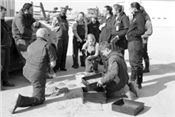|
MU Vet Students Take Research To Dairy Parlors And Pastures
 University of Missouri veterinary students learned how to use a platemeter to calibrate forage cuttings. The University of Missouri veterinary students learned how to use a platemeter to calibrate forage cuttings. The
hands-on training is part of an MU School of Veterinary Medicine production medicine class that combines
classroom work with visits to dairy farms across the state.
Credit: Photo courtesy of Stacey Hamilton
COLUMBIA, MO.
The University of Missouri veterinary students take campus research to parlors and pastures to help dairy farms improve.
The MU School of Veterinary Medicine’s production medicine class is a popular elective, offering students two-way learning opportunities. Students share university research with farmers, and farmers share their day-to-day practices with students.
Students interested in large-animal medicine spend a seven- to eight-week block studying dairy, beef and swine. Extension veterinarian Scott Poock leads the 16-member team.
Team members visit farms to practice what they have learned in the classroom. The five selected dairy farms, and MU’s Foremost Dairy Research Center near Columbia, show how diverse the dairy business can be. “I try to give them a flavor of different farms,” Poock says.
They arrive at farms prepared to look, listen and learn. Poock gives students spreadsheets on each dairy prior to visits. They study the dairy’s background – housing style, workforce, milk quality, heifer development, nutrition and reproduction methods – and compare the data with industry benchmarks before they begin their walk through bunks, pens and parlors.
They pack instruments, checkoff sheets, syringes and needles, and roll up their sleeves. They zero in on five areas: nutrition management, reproduction/herd health, housing, calf raising and parlor management. This year the class also addressed labor management.
Team members identify areas where dairy farmers can reduce mastitis and improve milk quality, efficiency and profits. Extension dairy specialist Stacey Hamilton teaches them the three M’s of dairy farm management: measure, monitor and manage. He also spends a day giving an overview of pasture-based dairy operations.
Students use iPads and low-cost (under $3) apps to record data. Poock says it is important to teach students and producers the habit of regularly observing and recording details.
When they return to campus, small groups of students discuss and analyze data and observations. Under Poock’s leadership, they make recommendations for the dairy farm based on the farm’s herd, barns, schedule, feed and workforce.
Poock also teaches students to balance communication skills with technical skills. Hiring and keeping the right employees is one of the most difficult tasks that producers face. “Sometimes the cows are the easy part,” he says.
Recent veterinary school graduate Jill Abel of Wright City was one of the dairy team members. Like the majority of her graduating class, she had a job waiting and ready for her upon graduation, she says. Abel began work at Hermann Veterinary Clinic on June 1. Her experiences at MU prepared her for her chosen role of small-town veterinarian by exposing her to many types of animal production systems.
“Every farm is different,” Abel says. She trained to follow Poock’s keen eye for detail. A small detail or habit often becomes so routine and everyday that the producer does not see it, she says. A new set of eyes can bring light to the root of a problem, allowing changes that increase efficiency.
Dairy farmer Dallas Cornelius says Poock and the team brought new ideas to his Easton dairy farm established in 1961 by his father. Cornelius’ Cla-Cor Farms milks 190-200 registered Holstein cows daily. Cornelius, his wife and partner Isaiah Clayton operate the farm with eight part-time employees.
Dairy team members explained the importance of newborn calves getting high-quality colostrum quickly. They drew blood to check and compare immunity levels to identify the problem before making a recommendation. Cornelius says they’ve seen improved immune systems since implementing the change.
The students showed Cornelius research indicating it was unnecessary to deworm calves at weaning. Cornelius switched to deworming calves at 4 months. The change saved time and money. “It was a quick and direct return,” he says.
Students also helped Cornelius adjust his vaccination schedule for mastitis. The improved protection helped the dairy’s somatic count drop to under 100,000. “That was a big improvement,” he says.
Cornelius says the changes recommended by students each year helped the dairy produce high-quality and high-volume milk. Last year, the dairy’s rolling herd average exceeded 25,000 pounds.
The dairy team has visited Cornelius’ dairy operation for more than five years. Each time, he says, he benefits from recommended changes. ∆

MU Extension veterinarian Scott Poock teaches students to look for details that matter to improve dairy
operations. Poock teaches MU veterinary students how to take university research to milking parlors.
Credit: Photo courtesy of Scott Poock.
|
|